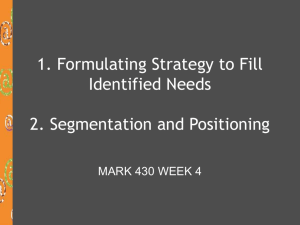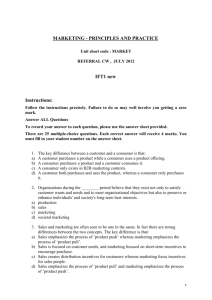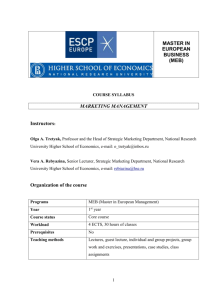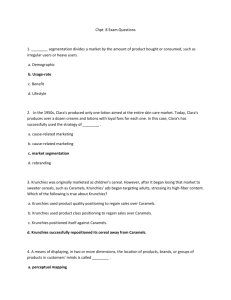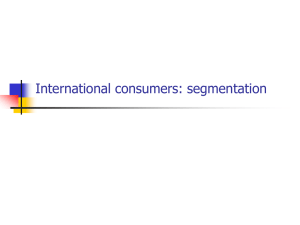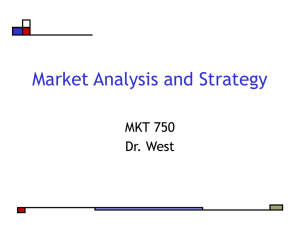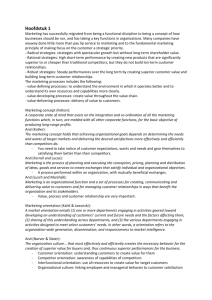Market Analysis and Strategy
advertisement
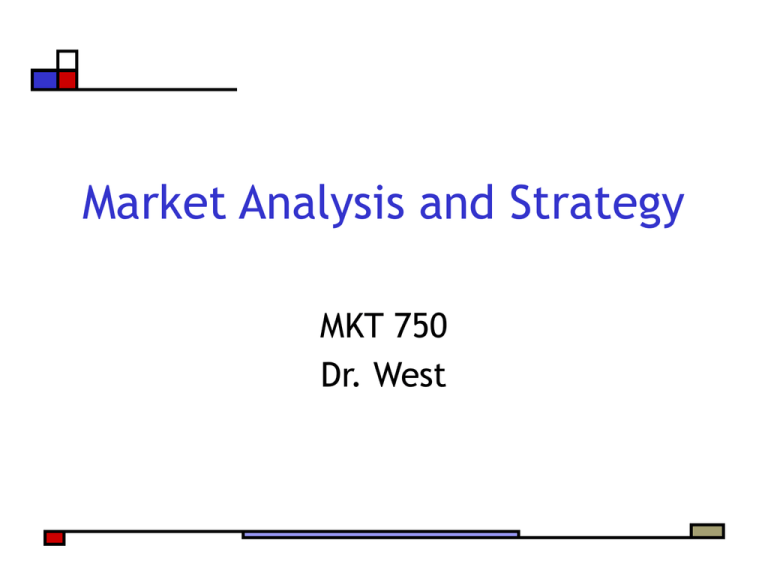
Market Analysis and Strategy MKT 750 Dr. West Agenda vs Free Association Task Reactions to merger Marketing Analysis & Strategic Planning Essential Elements (5Cs, STP, 4Ps) Situation Analysis / Strategy / Marketing Mix Marketing Strategy Involves the allocation of resources to develop and sell products or services that consumers will perceive to provide more value than competitive goods What is perceived value? Foundations of Strategy A thorough understanding of: Domestic and global market trends Models to predict purchase and consumption Communication methods to reach target markets most effectively Situation Analysis Consumer Company Competitors Collaborators Context Implementation in Marketplace Marketing Mix Product, Price, Place, Promotion, Brand STP Segmentation Targeting Positioning Situation Analysis Consumer Company Competitors Collaborators Context Implementation in Marketplace Marketing Mix Product, Price, Place, Promotion, Brand STP Segmentation Targeting Positioning Situation Analysis The process of analyzing: Consumer characteristics & trends Resources of the Company Current and potential Competitors Current and potential Collaborators The Context or environmental factors PEST Analysis Economic Factors Political Factors Context (Environment) Technological Developments Societal Trends Situation Analysis SWOT: Core strengths? Current weaknesses? What opportunities exist? What threats do we face? Situation Analysis Consider the situation are currently facing. and What do we know about the company? What do we know about its competitors? Who does the company collaborate with? What do we know about consumers? What about context (environmental factors and trends)? Situation Analysis Company Resources: Finances, Employees, Production, Development and Design, Research,Facilities, Marketing/Advertising What are Strengths? Weaknesses? & Situation Analysis Competitors Who are they? What are their advantages/disadvantages? How will competitors react? Situation Analysis Consumers Who are our current and potential customers? What do we know about these individuals? How do they compare to those who shop at the competitor stores? Situation Analysis Collaborators Whose strengths best complement ours? How will each partner benefit from a strategic alliance? Risks & rewards of collaboration? SWOT Analysis Strengths: Weaknesses: Opportunities: Threats: Situation Analysis Consumer Company Competitors Collaborators Environmental Factors Implementation in Marketplace Marketing Mix Product, Price, Place, Promotion, Brand STP Segmentation Targeting Positioning Strategy Segmentation: Process of identifying a group of people similar in one or more ways, based on a variety of characteristics and behaviors. Goal: minimize variance within groups and maximize variance between groups Identifying Market Segments Behavioral “Heavy versus Light” Users – “80/20 rule” Behavioral Segmentation: “Heavy versus Light” Users – “80/20 rule” Heavy Half (top 50%) Light Half (bottom 50%) Bourbon 95% 5% (20%) Canned Ham 86% 14% (32%) Colas 90% 10% (88%) Hair Tonic 87% 13% (48%) Toilet Tissue 71% 29% (95%) Heavy Users: Efficiency/profit Caution: Majority Fallacy Identifying Market Segments Consumer Characteristics Demographics: Age, Gender, Income, etc… Consumer Characteristics Geodemographics Examine regional differences in demographics Useful for store location decisions and targeting direct mailings Why? Prizm by New Beginnings: Filled with young, single adults, New Beginnings is a magnet for adults in transition. Many of its residents are twenty-something singles and couples just starting out on their career paths -or starting over after recent divorces or company transfers. Ethnically diverse -with nearly half its residents Hispanic, Asian or African-American- New Beginnings households tend to have the modest living standards typical of transient apartment dwellers. Identifying Market Segments Psychographics/ Benefits Psychographics Lifestyle segmentation VALS is based on primary motivation and resources Segment Profiles Once a basis for segmentation has been determined, segments should be profiled by describing them on as many levels as possible. & Customer Profile Age, Education, Income (SES) Occupation, Hobbies Media Habits Prizm Clusters Musical Taste, Preferred Cars Aspirational Role Models Strategy Targeting Select segments of the market to offer products and services Who can we most efficiently and effectively establish a relationship with better than our competitors? What criteria should be used to select a target market? Strategy Positioning How your product/company is perceived in the hearts and minds of your customers? Price leader/Innovator/Fashion leader/ Quality/Service What associations come to mind? Summary A firm needs to: Analyze the market 5 C’s (Company, Competitors, Collaborators, Customers, and Context) Develop a strategic plan beginning with Segmentation, Targeting, and Positioning Followed by tactical decisions Product (Brand), Price, Promotion, and Place Implementation issues DDB Needham Dataset Familiarize yourself with the data Heavy Users/Owners/Viewers versus AIO/Personality Table 1 and 1a: Household Characteristics Table 2 and 2a: Female Employment & Motivation Table 3 and 3a: Income & Education Table 4 and 4a: Occupation Table 5 and 5a: Age & Ethnic Subculture Table 6 and 6a: Gender & Geographic Region Table 7 and 7a: Personality Assignment Read Chapter 12 (pp 422 - 426, 429 - 445) Topic: Self-Concept & Lifestyle Assignment: Visit www.sric-bi.com/VALS and www.yankelovich.com and complete the VALS and Monitor surveys. Bring your results to class. DDB Needham Exercise: p. 447 # 2

